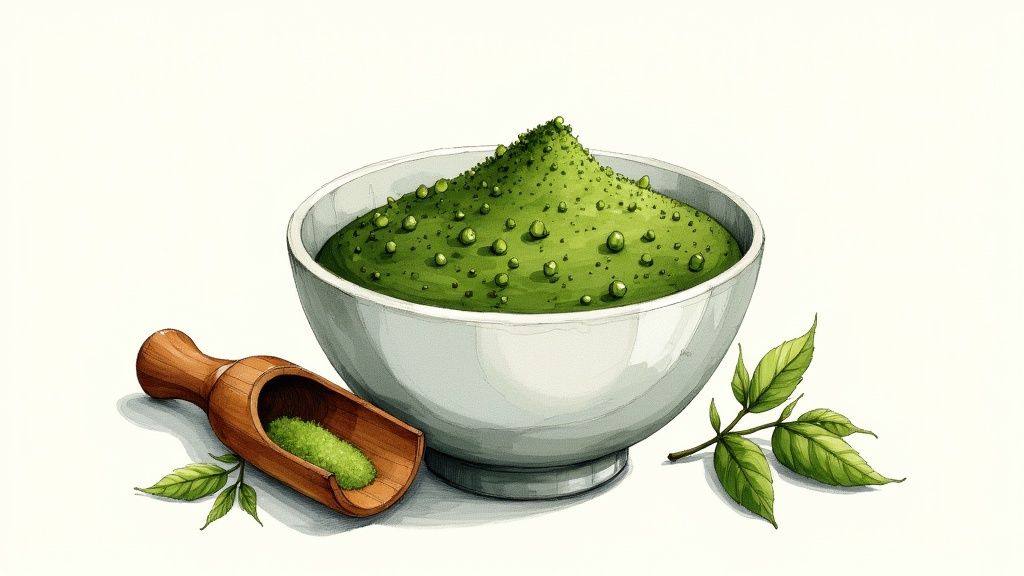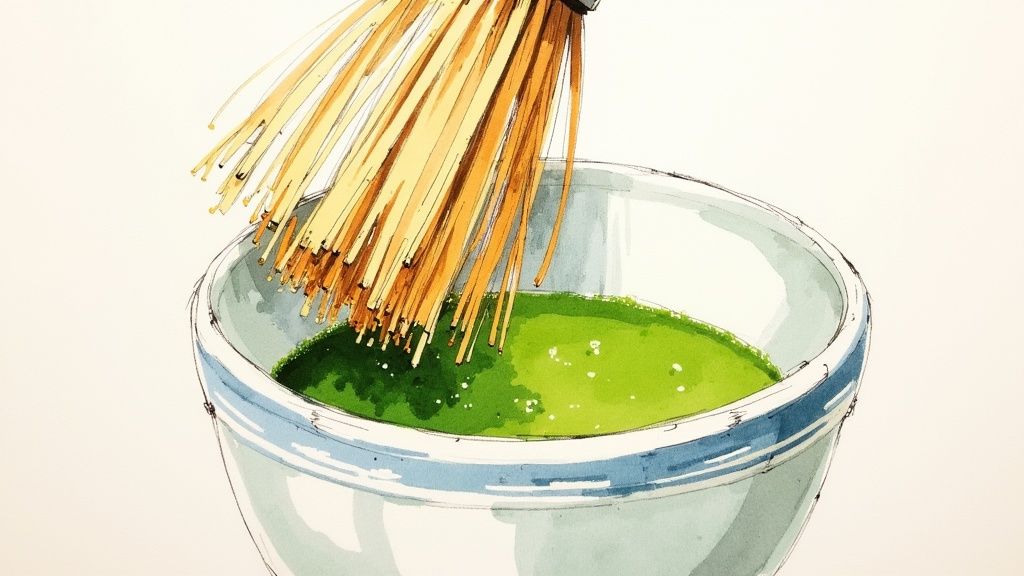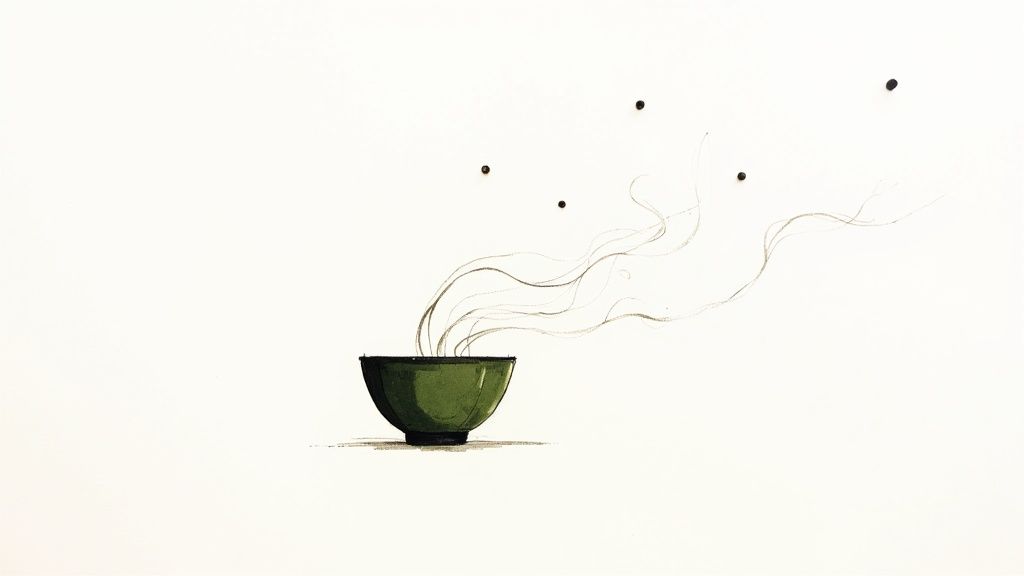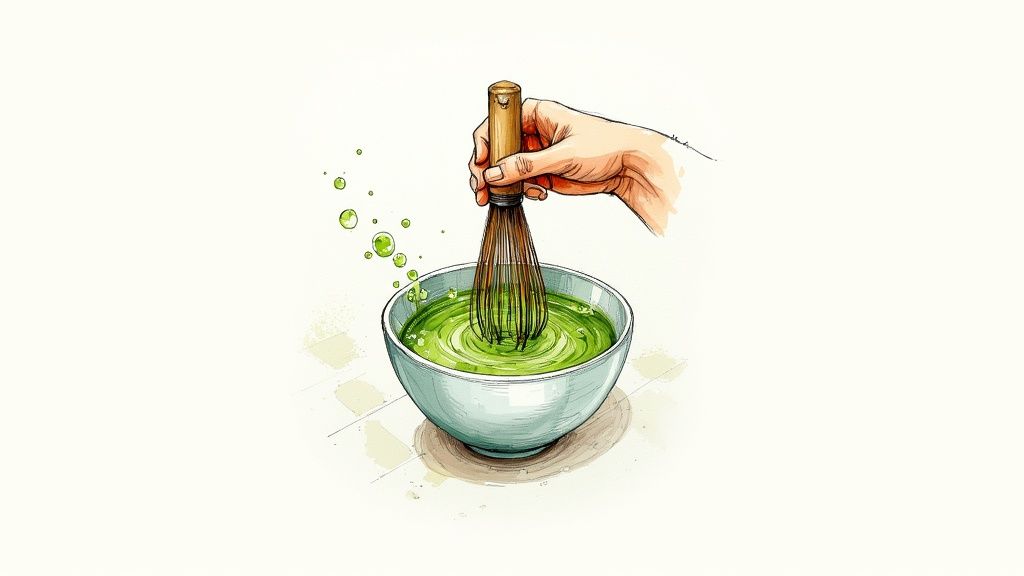The Journey from Tea Leaf to Perfect Cup

The path from tea leaf to matcha begins with careful cultivation. This special green tea represents centuries of Japanese expertise, where each step from growing to grinding shapes its unique character and cultural significance.
The Significance of Shade-Growing
Before harvest, farmers shield matcha tea plants from direct sunlight for several weeks. This traditional Japanese technique does more than just protect the leaves – it fundamentally changes their chemistry. The reduced sunlight causes the plants to produce more chlorophyll, giving the leaves their deep green color. At the same time, the plants create higher levels of L-theanine, an amino acid that gives matcha its smooth taste and calming effects.
From Harvest to Tencha
After picking, the leaves go through precise processing steps. First, they're steamed to stop oxidation and keep their fresh qualities. Then workers spread them out to dry, creating what's known as tencha. This stage marks a key difference between matcha and other green teas – while most tea leaves are simply steeped in water, tencha is destined to become the fine powder we know as matcha.
The Art of Stone-Grinding
The real magic happens when tencha meets the granite stone mill. These traditional mills turn the dried leaves into an incredibly fine powder through a gentle, unhurried process. By grinding slowly, the mills prevent heat from building up and damaging the leaves' delicate compounds and flavors. This time-tested method creates the silky-smooth powder that dissolves perfectly in water, ready to become a proper cup of matcha.
Identifying Quality Matcha
Choosing good matcha means knowing what to look for. High-quality matcha shows off a bright, vivid green color – steer clear of dull or yellowish powders. When you touch it, the texture should feel as fine as makeup powder, with no rough or gritty bits. Fresh matcha gives off a clean, plant-like smell with subtle sweet notes. If it smells stale or musty, that's a red flag. These simple checks help you pick matcha that will give you the best experience in your cup. Each careful step in matcha's creation, from shaded growing to stone grinding, builds toward that perfect moment when powder meets water and centuries of tradition come to life.
Essential Tools and Their Impact on Taste

Making matcha tea is both an art and a skill that requires specific tools to achieve the perfect cup. Each tool serves a distinct purpose in extracting the full flavors and creating the right texture. Understanding how to use these traditional implements helps you appreciate their role in crafting an exceptional matcha experience.
The Chasen: The Heart of the Matcha Experience
The bamboo whisk, known as a chasen, is the most essential tool for preparing matcha tea. Made from a single piece of bamboo and carved by hand, its delicate tines create the signature froth that makes matcha special. This froth does more than look pretty – it helps release the tea's complex flavors and creates a smooth, velvety texture. While electric frothers might seem convenient, they can't match the fine, uniform bubbles that a chasen produces. That's why serious matcha drinkers invest in a quality bamboo whisk to get the most from their tea.
The Chawan: More Than Just a Bowl
The chawan (matcha bowl) plays a key role in the tea preparation process. Its wide opening and shallow depth give the whisk enough room to create that perfect froth. The bowl's craftsmanship adds to the overall experience – artisans create unique textures and glazes that make each sip more meaningful. For example, bowls with subtle ridges on the inside help the whisk move more effectively, resulting in smoother tea. The size and shape of a chawan have been refined over centuries to create the ideal vessel for enjoying matcha.
Other Essential Tools for Matcha Preparation
Several other tools work together to create the perfect cup of matcha:
- Sifter: Breaking up clumps with a fine-mesh sifter ensures your tea stays smooth and lump-free. This simple step makes a big difference in the final texture.
- Chashaku: This small bamboo scoop measures just the right amount of matcha powder for each serving, helping you brew consistently good tea every time.
- Water: Though not technically a tool, water quality and temperature matter just as much as any implement. Water at 175°F (80°C) brings out matcha's best qualities without making it bitter.
Taking good care of these tools helps them last longer and work better. Regular cleaning and proper storage keep them in top condition. When you understand how each tool contributes to the final cup, you'll make better matcha and gain a deeper appreciation for this traditional preparation method.
Mastering the Art of Traditional Whisking
Let's explore the core technique that makes exceptional matcha – whisking. Far from just mixing ingredients together, proper whisking creates that signature frothy texture and brings out matcha's complex flavors. Here's how to master the traditional whisking method with your chasen bamboo whisk.
The Whisking Dance: Achieving the Perfect Froth
Creating the ideal matcha texture requires gentle skill – you're aiming for a smooth, creamy froth with tiny, uniform bubbles. Similar to whipping cream, the key is using consistent, measured movements rather than aggressive stirring. Start by sifting your matcha powder into the chawan bowl and adding about ¼ cup of hot water at 175°F (80°C). Hold your chasen with a relaxed grip and whisk in quick "W" or "M" motions, keeping the whisk from scraping the bottom. This protects the delicate bamboo tines while developing those prized micro-bubbles that enhance both texture and flavor.
Common Whisking Mistakes and How to Avoid Them
Even experienced matcha drinkers can struggle with whisking technique. Pressing too hard with the chasen leads to clumping and can damage your whisk. Moving too slowly won't generate enough froth, leaving you with thin, flat tea. Think of it like starting a fire – you need quick, steady motion to create the right conditions. Getting the water ratio right is also crucial. Too much water dilutes the tea's character, while too little creates an overly thick paste. Take time to experiment with different amounts until you find your ideal consistency.
Adapting Your Technique for Different Matcha Grades
Each grade of matcha requires subtle adjustments to your whisking approach. Like adjusting cooking temperatures for different ingredients, ceremonial grade matcha needs a lighter touch compared to culinary grade varieties. The finer powder of ceremonial matcha is already optimized for smooth texture and clean taste. Meanwhile, culinary grade matcha benefits from slightly more vigorous whisking to fully develop its flavor profile. Pay attention to how different grades respond as you whisk – this awareness helps you consistently make excellent matcha. With practice, you'll develop an intuitive feel for working with various matcha types. Next, we'll look at modern preparation methods that honor tradition while making matcha more accessible.
Modern Adaptations Without Sacrificing Tradition

While preparing matcha with a traditional chasen and chawan creates an authentic experience, many people need faster ways to enjoy this centuries-old drink in their busy lives. The good news is that you can adapt your matcha routine without losing what makes it special. Let's explore how to balance time-saving techniques while preserving the essential qualities of matcha.
The Electric Frother: A Worthy Alternative?
Many matcha beginners wonder if an electric frother can replace the bamboo whisk. The truth is, while a chasen creates the finest, most delicate froth, an electric frother works well for everyday preparation. For example, when making a quick morning matcha latte, an electric frother produces good results. But for special occasions or when using high-grade matcha, stick with the chasen – its bamboo tines create tiny bubbles that bring out subtle flavors and aromas that electric frothers often miss. Choose based on what matters most to you: speed or tradition.
Simplifying Your Matcha Routine
You can make your matcha preparation more efficient beyond just the whisking method. Using a temperature-controlled kettle takes the guesswork out of reaching the ideal 175°F (80°C) water temperature. A pre-measured scoop, similar to the traditional chasaku, helps portion your matcha quickly and accurately. These small adjustments let you enjoy matcha's rich taste and benefits even during hectic days.
Respecting Tradition in a Modern Context
Some key steps should never be skipped, even when using modern methods. Always sift your matcha powder first – this prevents clumps and ensures a smooth cup, no matter how you whisk it. High-quality filtered water also makes a big difference, just like it does with coffee. These basic elements are essential to good matcha, regardless of your preparation style.
Adapting Techniques for Different Styles
Different matcha drinks need different approaches. Traditional thin tea (usucha) needs quick, vigorous whisking, while thick tea (koicha) requires gentle, slow stirring. When making lattes or smoothies, you'll need to adjust how much powder and liquid you use based on the other ingredients. Here's a simple guide:
| Matcha Style | Whisking Technique | Water Amount | Consistency |
|---|---|---|---|
| Usucha (Thin Tea) | Vigorous, W-shaped motions | More water | Light and frothy |
| Koicha (Thick Tea) | Slow, gentle folding | Less water | Thick and paste-like |
| Matcha Latte | Moderate whisking, blending with milk | Variable | Creamy and smooth |
By understanding these different preparation methods and choosing the right modern tools, you can make matcha part of your daily routine while keeping its special qualities intact. The key is finding what works for you while respecting the basics that make matcha unique.
Maximizing Health Benefits Through Proper Preparation

The way you prepare your matcha directly affects how many health benefits you get from each cup. While making matcha may seem simple, small details in the preparation process can make a big difference in unlocking its full nutritional potential. Let's explore how specific preparation techniques help you get the most out of your daily matcha ritual.
The Importance of Water Temperature
Getting the water temperature right is essential for preserving matcha's beneficial compounds. While you might be tempted to use boiling water for a quick cup, this can actually damage the tea's delicate antioxidants called catechins. These compounds, which may help protect heart health, stay intact best when using water heated to about 175°F (80°C). By taking care with water temperature, you ensure those valuable antioxidants remain active in your cup.
Whisking for Optimal Nutrient Release
The whisking step does more than create an appealing frothy texture – it actually helps release more nutrients from the tea powder. When you whisk vigorously with a bamboo chasen or electric frother, you break down the matcha particles more completely. This makes beneficial compounds like L-theanine more available for your body to absorb. For example, proper whisking helps create that signature balanced energy boost that comes from matcha's combination of L-theanine and caffeine working together.
Serving Size and Frequency: Finding Your Balance
Like any caffeinated drink, it's important to find the right amount of matcha for your needs. While matcha offers many health perks, having too much can lead to caffeine-related side effects. Most people do well with 1-2 grams of matcha powder per cup. The timing matters too – a morning cup can provide steady energy through your day, but drinking matcha close to bedtime might disrupt sleep for some people. Read more about proper preparation in our guide to How to master matcha preparation at home.
Adapting Your Matcha to Dietary Needs
One of matcha's strengths is how easily it fits into different eating patterns. If you follow a vegan diet, matcha provides valuable plant-based antioxidants and nutrients. For those watching blood sugar, matcha offers sustained energy without dramatic spikes. The minimal calories in plain matcha also make it a good fit for weight management goals.
Practical Tips for Maximizing Benefits
- Use filtered water: Clean water helps preserve matcha's beneficial compounds and gives the best flavor
- Store matcha properly: Keep your powder in an airtight container away from light and heat to maintain freshness
- Experiment with different grades: Try various matcha grades to find what works best for your taste and wellness goals
- Listen to your body: Pay attention to how matcha affects you and adjust your preparation routine accordingly
By following these preparation guidelines mindfully, you can create a daily matcha practice that supports your health and wellbeing goals.
Troubleshooting Your Path to Matcha Mastery
Creating the perfect cup of matcha takes practice and attention to detail. Even experienced matcha enthusiasts face challenges from time to time. Let's explore common issues you might encounter and learn practical solutions to help you consistently create delicious matcha tea.
Tackling Clumping and Bitterness
Clumping is one of the most frequent problems when preparing matcha, leading to an unpleasant gritty texture in your tea. This typically happens when you skip sifting or don't whisk properly. Water temperature also plays a crucial role – using water above 175°F/80°C can scorch the delicate tea powder, similar to how overcooked vegetables lose their subtle flavors. To avoid these issues, always sift your matcha first and keep your water at the right temperature. Use quick, steady strokes with your chasen bamboo whisk (or electric frother) to break up any remaining clumps and create a smooth texture.
Addressing Inconsistent Results
Have you noticed that your matcha tastes amazing one day but falls flat the next? These variations usually point to small differences in your preparation method. For instance, you might use slightly different amounts of powder each time or heat your water to different temperatures. Much like baking requires exact measurements for best results, matcha preparation benefits from precision. Try using a kitchen scale for your matcha powder and a thermometer for water temperature. These simple tools can help you achieve more reliable results every time.
Adapting to Different Matcha Grades and Environments
Each type of matcha requires slightly different handling. High-quality ceremonial grade matcha needs gentle treatment due to its fine texture, while culinary grade can withstand more vigorous whisking. Your local climate matters too – in dry weather, you might need to reduce water slightly to get the right consistency. Think of it like adjusting your cooking method for different ingredients – what works perfectly for one grade of matcha might need tweaking for another. Pay attention to how your matcha responds and adjust accordingly.
Maintaining Optimal Freshness
Like all fine teas, matcha's quality gradually declines when exposed to light, air, and moisture. Its bright green color and fresh taste depend on proper storage. Keep your matcha in an airtight container away from light, preferably in the refrigerator. Much like storing fresh herbs, protecting matcha from these elements helps preserve its vibrant flavor and color. With proper care and attention to these details, you'll be able to enjoy consistently excellent matcha.
Ready to elevate your matcha experience? Explore our premium selection of matcha and traditional tools at matcha-tea.com and discover everything you need to create the perfect cup.
